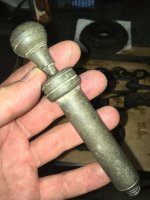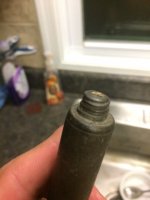WilliVanilli
Jr. Member
- Mar 17, 2018
- 77
- 148
- Primary Interest:
- All Treasure Hunting
Found this today detecting a creek near an early colonial homesite. At first, thought it was a vintage bike pump. Then thought it was a early syringe. Now going with grease gun. Plunger still slides and works with compression. Tip was clogged but after poking through, some greyish stuff came out. Stamped “JS” on top of the rim. Any help would be appreciated. Thanks!




Attachments
Last edited:

















